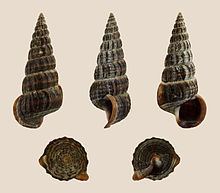Genus Cerithideopsis | Scientific name Cerithidea californica | |
 | ||
Similar Cerithidea, Cerithideopsis pliculosa, Batillaria attramentaria, Batillaria, Euhaplorchis californiensis | ||
Cerithideopsis californica, common name the California hornsnail or the California horn snail, is a species of sea snail, a marine gastropod mollusk in the family Potamididae. This series was previously known as Cerithidea californica.
Contents
Distribution
The distribution of Cerithideopsis californica is from central California, USA to Baja California Sur, Mexico.
The type locality is "California, in brackish water".
Description
The shape of the shell is turriform and is about 1 inch (25 mm) in length.
Ecology
Cerithideopsis californica lives in salt-marsh dominated estuaries.
The snails primarily feed on benthic diatoms.
Throughout its range in California, these snails grow and reproduce from spring through fall (March–October) and cease growth and reproduction during the winter (November–February). Maximum longevity for these snails is at least 6–10 years, and this appears to be the case for uninfected as well as infected snails.
At least 18 trematode species parasitically castrate California horn snails. A trematode infects a snail with a miracidium larva that either swims to infect the snail, or hatches after the snail ingests the trematode egg. After infection, the trematode parthenitae clonally replicate and produce free-swimming offspring (cercariae). These offspring infect second intermediate hosts (various invertebrates and fishes) where they form cysts (metacercariae). The trematodes infect bird final hosts when birds eat second intermediate hosts.
